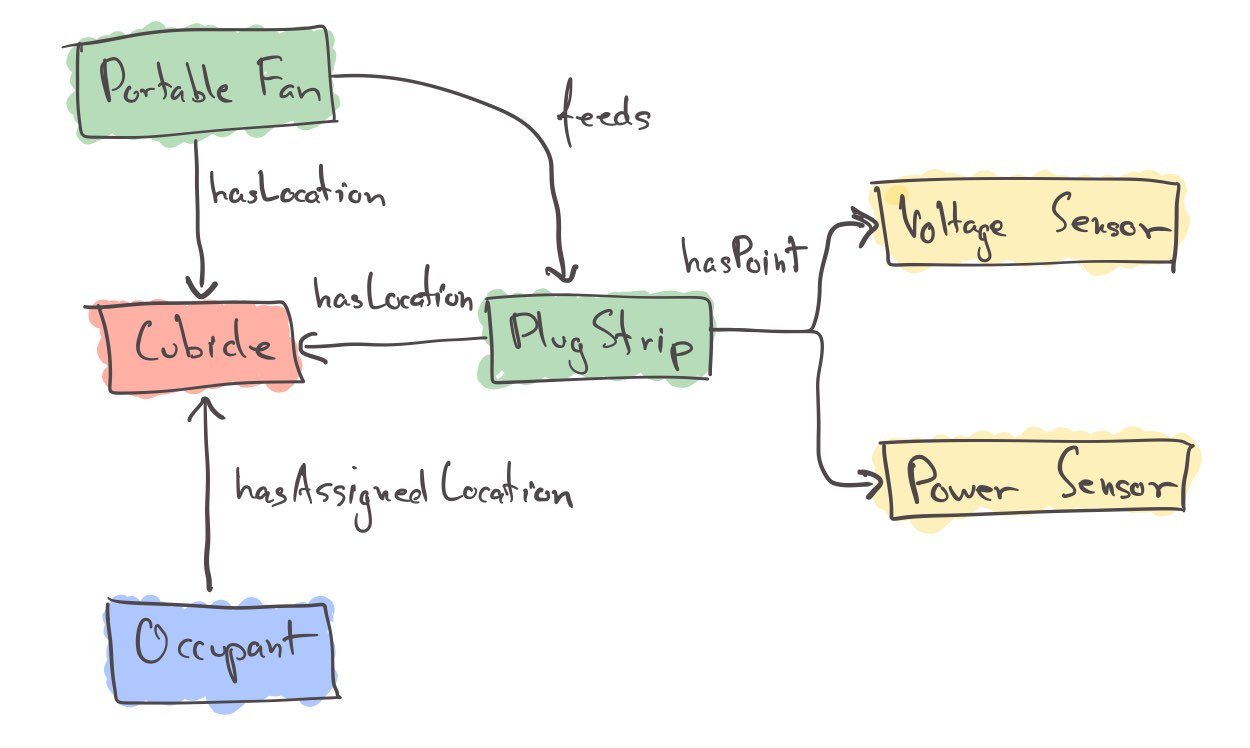Docs available here
Look at the .ttl files for the ontology extension definition. Look at example1.ttl for usage. Look at sample_queries.py for what it says on the tin.
The extension introduces some classes for describing properties of the building occupants. An Occupant is any individual or group of individuals. An Individual is a subclass of Occupant corresponding to a single individual. A Group is also a subclass of Occupant.
Occupant Properties:
occ:isMemberOf <Group>: an occupant can be a member of a group. This allows nested groupsocc:hasAccessTo <Equipment>: an occupant can use equipment.occ:label <string>: a human-readable label associated with the occupantocc:age <value>: the age of an occupant given as a range or exact value. Can be in years, months, days, etcocc:clothingInsulation <value>: the clothing insulation level of an occupant, incloocc:gender <value>: the surveyed gender of an occupantocc:ethnicity <value>: the surveyed ethnicity of an occupant
Individual Properties:
- An individual can have any or all of the properties associated with an Occupant
Group Properties:
- A group can have any or all of the properties associated with an occupant, including...
occ:hasMember <Occupant>: the inverse relationship ofocc:isMemberOfocc:groupSize <integer>: the number of individuals in a group
For items like age range, gender and ethnicity it is important to capture not just the value that was surveyed, but also the range of values that was contained in the survey. A possible way of modeling this has been done for AgeRange, but not for ethnicity or gender (yet).
How does it work? An occ:AgeRange class is declared with several pre-declared instances: occ:18_25, occ:26_34, occ:35_50 and occ:51_plus. There are annotations on these instances which explicitly denote the upper/lower bounds of each age range, but I'll omit that here for simplicity. In the example1.ttl file, the value of the occ:ageRange property for an Occupant entity is one of these range instances. For surveys with different ranges, the data graph should define its own classes with the occ:upperBound and occ:lowerBound properties to denote what the actual age ranges are.
The extension introduces several new classes of equipment:
- Ceiling Fan
- Personal Devices:
- Portable Fan
- Portable Heater
- Desktop Light
- Envelope Equipment:
- Door
- Window
- Plug Meter
The extension supports several kinds of annotations on equipment entities:
occ:modeOfControl: manual, dynamic or automaticocc:degreeOfControl: on/off, continuous, staged, noneocc:occupantAccessibility: shared, adjustable or not accessibleocc:isAccessibleBy <Occupant>: denotes which occupants, individuals or groups make use of an equipment. If at least 1 occupant has access to an equipment, the ontology will infer theAdjustableproperty for the equipment. If at least 2 occupants have access to an equipment then the ontology will also infer theSharedproperty.
Plug meters are a new class of equipment that is a subclass of brick:Electrical_Meter. Plug meters have their data sources related to them through brick:hasPoint: this is how to model voltage, current, power, energy and other kinds of sensors with a meter. To indicate which piece of equipment is measured by the plug meter use brick:isFedBy (the equipment "feeds" electricity to the meter). Plug meters are related to a cubicle, floor, room or other location via brick:hasLocation.
@prefix brick: <https://brickschema.org/schema/Brick#> .
@prefix occ: <https://brickschema.org/schema/Brick/extension/occupancy#> .
@prefix unit: <http://qudt.org/vocab/unit/> .
@prefix ex: <urn:example#> .
ex:Cubicle123 a brick:Cubicle ;
brick:isLocationOf ex:DeskFan1, ex:Cubicle123PowerMeter .
ex:DeskFan1 a brick:Portable_Fan ;
brick:feeds ex:Cubicle123PowerMeter .
ex:Cubicle123PowerMeter a brick:PlugMeter ;
brick:hasPoint ex:volt_sensor_1, ex:power_sensor_1 .
ex:volt_sensor_1 a brick:Voltage_Sensor ;
brick:hasUnit unit:V ;
brick:timeseries [
brick:hasTimeseriesId "ac3a9e-c4e9-11eb-ae8d-1002b58053c7" ;
] .
ex:power_sensor_1 a brick:Power_Sensor ;
brick:hasUnit unit:W ;
brick:timeseries [
brick:hasTimeseriesId "571811de-c4e9-11eb-ae8d-1002b58053c7" ;
] .The extension introduces a new kind of Point class which models streams of occupant actions. An instance of a occ:OccupantActionStream represents the sequence of actions taken by an occupant (which may be an individual or a group) on an equipment. This is different than a Point containing data of the equipment status such as a brick:Status or brick:Command. An occ:OccupantActionStream contains the results of occupant actions; a brick:Status/brick:Command contain the current read-only state of equipment and read-write state of equipment, respectively.
Specifically, the occ:OccupantActionStream instance has the following metadata:
- the
occ:Occupantinstance taking the action (related with thebrick:isPointOfrelationship) - the
brick:Equipmentinstance that is the object of the action (related with thebrick:isPointOfrelationship)
- a
occ:csvReferenceproperty denoting the name of a CSV file containing the data and which column contains the data for this point. Alternative toocc:csvReferenceisbrick:timeserieswhich relates a Point instance's data to the contents of a database
The values of the data stream are the resulting state of the equipment after the occupant took an action.
Is there a better/standard way of describing the data stored in a tabular form?
- https://link.springer.com/content/pdf/10.1007/s10115-020-01468-x.pdf
- https://www.w3.org/TR/r2rml/
- https://github.com/w3c/csvw/
For example, consider a file Occupant1DeskFanActions.csv which contains the following data:
timestamp,action
2021-04-01T08:00:00Z,on
2021-04-01T09:00:00Z,off
2021-04-01T09:10:00Z,on
then this would possibly be modeled in a .ttl file as:
@prefix brick: <https://brickschema.org/schema/Brick#> .
@prefix occ: <https://brickschema.org/schema/Brick/extension/occupancy#> .
@prefix ex: <urn:example#> .
ex:Building a brick:Building ;
brick:hasPart ex:Floor1 ;
.
ex:Floor1 a brick:Floor ;
brick:hasPart ex:Office1 ;
.
ex:Office1 a brick:Office ;
occ:isAssignedLocationOf ex:Occupant1 ;
brick:isLocationOf ex:DeskFan1 ;
.
ex:DeskFan1 a occ:Portable_Fan ;
occ:isAccessibleBy ex:Occupant1 ;
.
ex:Occupant1 a occ:Individual ;
occ:label "Occupant 1" ;
occ:hasAssignedLocation ex:Office1 ;
.
ex:Occupant1FanActions a occ:OccupantActionStream ;
brick:isPointOf ex:Occupant1, ex:DeskFan1 ;
occ:csvReference [
occ:fileName "Occupant1DeskFanActions.csv" ;
occ:dataColumnName "action" ;
occ:timeColumnName "timestamp" ;
] ;

